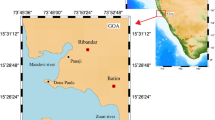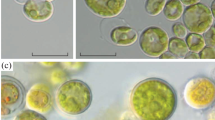Abstract
A study was made of growth and carotenogenesis in eight strains of the green algaDunaliella salina collected from salt ponds at Salar de Atacama (23° 30′ S; 68° 15′ W) and Antofagasta (23° 39′ S; 70° 24′ W), Chile and kept in unialgal cultures at the Laboratorio Cultivo de Algas, University of Concepcion. The algae were grown in Erdschreiber medium supplemented with 12.5% w/v NaCl, under a continuous photon flux density of approximately 150 μmol m-2 s-1 at 25 ± 4 °C without aeration. When growth reached the stationary phase, the amount of NaCl was increased to 25%. Total carotenoid content was measured during the exponential growth phase and 20 days after the addition of salt. Strain CONC-001 (Laguna La Rinconada, Antofagasta) exhibited the highest growth rate (k = 0.32 div d-1) and the lowest total carotenoid content (7.2 and 13.7 mg l-1 at 12.5 and 25% NaCl, respectively). Strain CONC-007 (Salar de Atacama) had the lowest growth rate (k = 0.14 div d-1) and yielded the highest total carotenes per volume unit (23.1 and 35.6 mg 1-1 at 12.5 and 25% NaCl) and per cell (ca. 42 pg at 25% NaCl). Total carotenoid synthesis did not increase in strains CONC-001 and CONC-006 with the increase of salinity. These strains had the greatest increase of total carotenoid-to-chlorophyll ratio (4.5- and 9.3-fold, respectively). The seven strains from Salar de Atacama had higher total carotenoid contents than the strain from Antofagasta. Cell size also varied. Strain CONC-001 cells were smallest; strain CONC-006 had the largest cells. There was an inverse correlation between maximum cell density and mean cell size.
Similar content being viewed by others
References
Ben-Amotz A (1980) Glycerol production in the algaDunaliella. In San Pietro A (ed.), Biochemical and photosynthetic aspects of energy production. Academic Press, New York, 191–208.
Ben-Amotz A (1986) β-carotene enhancement and its role in protectingDunaliella bardawil against injury by high irradiance. In Barclay WR, McIntosh RP (eds), Algal biomass technologies. An interdisciplinary perspective. J. Cramer, Berlin-Stuttgart, 132–135.
Ben-Amotz A, Avron M (1980) Osmoregulation in the halophilic algaeDunaliella andAsteromonas. In Rains DW, Valentine RC, Hollander (eds), Genetic engineering of osmoregulation. Plenum Publishing Corp. New York, 91–100.
Ben-Amotz A, Katz A, Avron M (1982) Accumulation of β-carotene in halotolerant algae: purification and characterization of β-carotene rich globules fromDunaliella bardawil (Chlorophyceae). J. Phycol. 18: 529–537.
Borowitzka MA (1988) Algal growth media and sources of algal cultures. In Borowitzka MA, Borowitzka LJ (eds), Microalgal Biotechnology, Cambridge U. P., Cambridge, 456–465.
Borowitzka LJ, Borowitzka MA, Moulton TP (1984) The mass culture ofDunaliella salina for fine chemicals: From laboratory to pilot plant. Hydrobiologia 116/117 115–125.
Borowitzka MA, Borowitzka LJ (1988)Dunaliella. In Borowitzka MA, Borowitzka LJ (eds), Micro-aggal biotechnology. Cambridge University Press, Cambridge, 27–58.
Díaz LS, Gómez-Silva B, Rodríguez L, Ortíz J (1988) Alfa-caroteno en microalga del géneroDunaliella. Rev. Chilena Nutrición 16 (2): 162.
Ginzburg M, (1987)Dunaliella: a green alga adapted to salt. Adv. Bot. Res. 14: 93–183.
Ginzburg M, Ginzburg BZ (1981) Interrelationships of light, temperature, sodium chloride and carbon sources in growth of halotolerant and halophylic strains ofDunaliella. Br. phycol. J. 16: 313–324.
Ginzburg M, Ginzburg BZ (1985) Studies of the comparative physiology of the genusDunaliella (Chlorophyta, Volvocales) 1. Response of growth to NaCl concentration. Br. phycol. J. 20: 277–283.
Gómez-Silva B, Olivares H, Rodríguez L (1990) Microalgae from northern Chile I. La Rinconada, a hypersaline aquatic habitat in the Atacama Desert. Est. Oceanol. 9: 73–76.
Gómez-Silva B, Rodríguez L, Díaz LS, Ortíz J (1988)Dunaliella sp., una microalga carotenogénica nativa de la II Región Chile. Arch. Biol. Med. Exp. 21(2): R-298.
Guillard RRL (1973) Division rates. In Stein JR (ed.), Handbook of Phycological Methods. Culture Methods. Culture Methods and Growth Measurements. Cambridge University Press, London, 289–311.
Loeblich LA (1982) Photosynthesis and pigments influenced by light intensity and salinity in the halophileDunaliella salina (Chlorophyta). J. mar. Biol. Ass. U.K. 62: 493–508.
Massyuk NP (1966) Mass culture of the carotene-bearing algaDunaliella salina Teod. Ukr. Bot. J. 23: 12–19.
Massyuk NP (1973) Morphology, taxonomy, ecology and geographic distribution of the genusDunaliella Teod. and prospects for its potential utilization. Naukova Dumka, Kiev, 244 pp. (original in Russian).
McLachlan J (1973) Growth-media-marine. In Stein JR (ed.), Handbook of Phycological Methods. Culture Methods and Growth Measurements. Cambridge University Press, London, 25–51.
Moulton TP, Burford MA (1990) The mass culture ofDunaliella viridis (Volvocales, Chlorophyta) for oxygenated carotenoids: laboratory and pilot plant studies. Hydrobiologia 204/205: 401–408.
Parra OO, González MA, Dellarossa V, Cifuentes AS, Conejeros M (1990a) Caracterización biológica de una cepa chilena deDunaliella salina potencialmente comerciable. Arch. Biol. Med. Exp. 23: 141–146.
Parra OO, Floyd GL, Wilcox LW (1990b) Taxonomic identification and ultrastructural characterization of a chilean strain ofDunaliella. Rev. Chilena Hist. Nat. 63: 239–245.
Romero H (1985) Geografia de los Climas. En: Instituto Geográfico Militar (ed.), Geografiá de Chile, Tomo XI. Impresión TT.GG. Instituto Geográfico Militar, 243 pp.
Starr RC (1964) The culture collection of algae at Indiana University. Am. J. Bot. 51: 1013–1044.
Strickland JDH, Parsons TR (1972) A Manual of Seawater Analysis. Bull. Fish. Res. Bd Canada 125, 310 pp.
Author information
Authors and Affiliations
Rights and permissions
About this article
Cite this article
Cifuentes, A.S., González, M., Conejeros, M. et al. Growth and carotenogenesis in eight strains ofDunaliella salina Teodoresco from Chile. J Appl Phycol 4, 111–118 (1992). https://doi.org/10.1007/BF02442459
Received:
Revised:
Accepted:
Issue Date:
DOI: https://doi.org/10.1007/BF02442459




